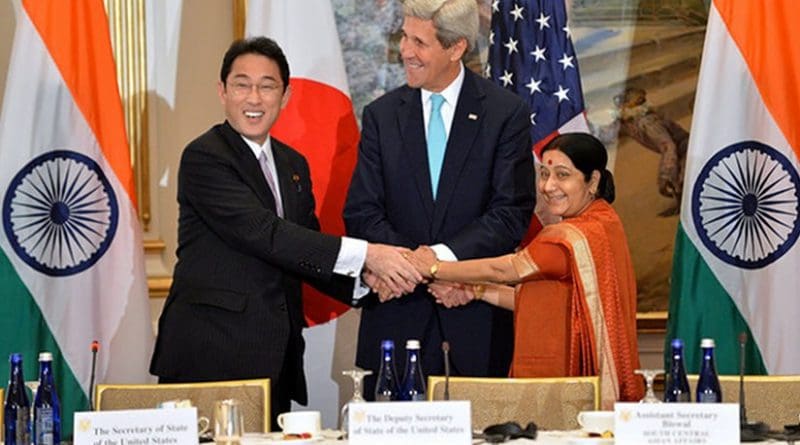India-Japan-US Trilateral: India’s Policy For The Indo-Pacific – Analysis
By IPCS
By Sandip Kumar Mishra*
In an interesting first, the foreign ministers of India, Japan and the US had a trilateral dialogue on the sidelines of the UN General Assembly on 29 September 2015. The foreign ministers underlined the strategic convergence of their interests in the Indo-Pacific region, specifically mentioning peaceful settlement of disputes, freedom of navigation and over flight, and unimpeded commerce in the region, along with the creation of a rule-based regional order. In another interesting twist, the leaders talked about the centrality of the ASEAN and the significance of the East Asia Summit in dealing with the key political and security issues of the region.
Although the dialogue does not name China, it undoubtedly points toward it, of which Beijing is certain to take note. India has avoided, for some time, its participation in any trilateral or multilateral dialogue that Beijing views as a target against itself, and it was probably for the same reason that the India-Japan-South Korea track 1.5 annual meeting was not able to continue after its first meeting in 2012. India has also been reluctant to make its annual Exercise Malabar a multilateral naval exercise targeted against China. Thus, this is an important shift in India’s policy for the Indo-Pacific, a glimpse of which was shown when the Indian Prime Minister Narendra Modi made his first state visit outside South Asia to Japan and that too for a five days. During his visit, Modi openly expressed India’s stand against any ‘expansionist’ state in the region. The shift is getting more obvious with India taking more specific steps to be part of an alliance that includes the US, Japan and Australia.
Being part of a multilateral network to create disincentives against China’s assertiveness may be the right choice for India. However, India should be careful when seeking to secure its interests through these arrangements. It would not be prudent to join Japan or the US who are articulating a confrontationist approach in their dealings with China. India should rather steer Japan and the US to adopt New Delhi’s approach to deal with China, which has been more nuanced and constructive. India’s approach in the trilateral dialogue with Japan and the US must be informed by this subtle understanding, otherwise India could become a pawn in the big power rivalry in the Indo-Pacific.
India should also try to make this platform wide and open. There cannot be any proper justification in leaving South Korea out of such a dialogue. South Korea, which is quite similar to India, has a multifaceted policy vis-à-vis China and its inclusion in the dialogue would have given more strength to the Indian position. Similarly, since the foreign ministers mentioned ASEAN and the East Asia Summit, it would have been better if a few representations from Southeast Asia had also been there. India must realise that rather than getting caught in great power politics, which is essentially a contest for dominance by one or another, the future of the Indo-Pacific would be more peaceful and prosperous if and when middle powers take centre-stage. Such a possibility in the changing landscape of the Indo-Pacific is not utopian; it can be realised, and India should try to articulate this option to further its national interests.
It seems that the Indian policy for the Indo-Pacific is focused around the big players such as the US, Japan and China. The approach does not capture the complex realities of the regional politics. A more detailed role for the middle must be understood and pursued in India’s scheme of things. India’s growing stature and role in the Indo-Pacific would not be determined only by the way it deals with the big players of the region but also by the way New Delhi connects with the middle powers of the region.
It seems that India has failed under the current foreign policy establishment to have a more detailed and interconnected foreign policy for the region. India needs to consider all important bilateral relationships in the region and try to devise a mechanism to coordinate among these in the fulfillment of its national interests. For example, India upgraded its bilateral relations with South Korea to a ‘Special Strategic Partnership’ during Modi’s visit to Seoul in May 2015. However, India’s growing unconditional support and proximity with Shinzo Abe would definitely put limitations on India-South Korea relations. Similarly, the much-publicised participation of the Indian Minister of State for Home Affairs Kiren Rijiju in North Korea’s Independence Day celebration in New Delhi is also likely to raise suspicions in South Korea.
Thus far, it seems that the foreign policy establishment in India under the new government is not able to completely decipher the complex diplomatic scenario of the Indo-Pacific region and has either been following the designs of the big players or making confused moves. Otherwise, how should one understand a trilateral dialogue with Japan and the US that talks about ASEAN’s centrality without any participation from the region? India needs to look beyond easy rhetoric and options and formulate a more informed foreign policy for the Indo-Pacific that is centered on its own national interests.
*Sandip Kumar Mishra
Assistant Professor, Department of East Asian Studies, Delhi University

